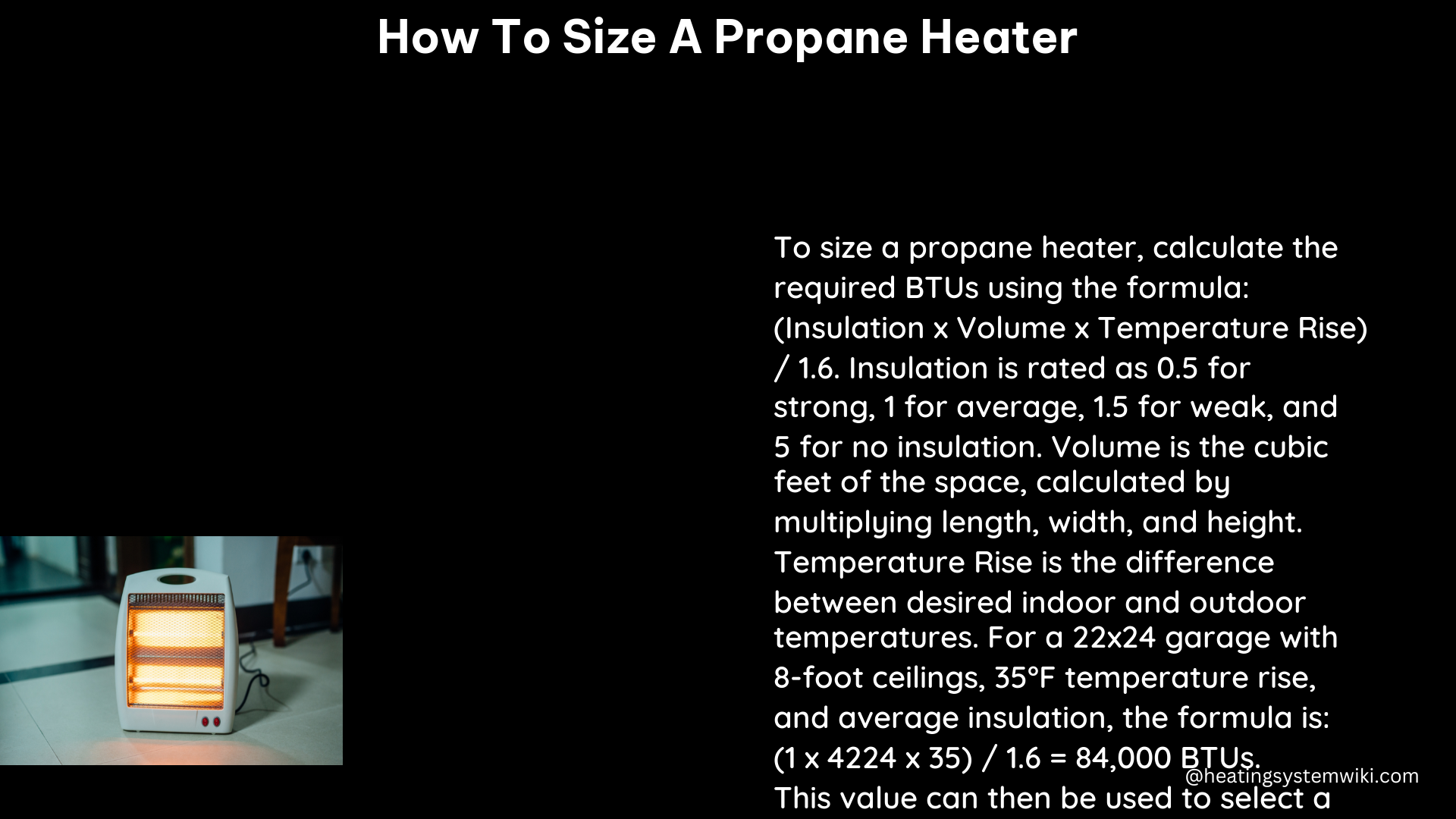Sizing a propane heater correctly is crucial to ensure efficient and safe heating for your space. Whether you’re heating a garage, workshop, or any other indoor area, the right-sized propane heater can make a significant difference in your comfort and energy costs. In this comprehensive guide, we’ll walk you through the step-by-step process of determining the appropriate size of a propane heater for your specific needs.
Calculating the Cubic Footage of the Space
The first step in sizing a propane heater is to calculate the cubic footage of the space you need to heat. This is done by multiplying the length, width, and height of the area. For example, if you have a 30-foot by 40-foot pole barn with 14-foot ceilings, the cubic footage would be:
30 feet x 40 feet x 14 feet = 16,800 cubic feet
Determining the Insulation Factor

The insulation factor is a crucial consideration when sizing a propane heater. This factor takes into account the level of insulation in your space, which affects the amount of heat required to maintain a comfortable temperature. The insulation factor can range from 3 (for well-insulated spaces) to 7 (for poorly insulated spaces). For an average level of insulation, the insulation factor is typically 5.
Calculating the Required BTUs
To determine the required BTUs (British Thermal Units) for your propane heater, you’ll need to multiply the cubic footage of the space by the insulation factor. This calculation will give you the total BTUs needed to heat the area effectively.
For the 16,800 cubic feet example, the calculation would be:
16,800 cubic feet x 5 (insulation factor) = 84,000 BTUs
This means that you would need a propane heater with a minimum output of 84,000 BTUs to adequately heat the 16,800 cubic feet space.
Considering Temperature Rise
The temperature rise is the difference between the desired indoor temperature and the outdoor temperature. A higher temperature rise will require more BTUs to achieve the desired warmth. For example, if you want to maintain an indoor temperature of 70°F and the outdoor temperature is 30°F, the temperature rise would be 40°F (70°F – 30°F).
As a general guideline, for every 10°F of temperature rise, you’ll need an additional 4,000 BTUs of heating capacity. So, if you have a 40°F temperature rise, you would need an additional 16,000 BTUs (4,000 BTUs x 4) to achieve your desired indoor temperature.
Importance of Insulation
Proper insulation is crucial when sizing a propane heater. Well-insulated spaces require fewer BTUs to maintain a comfortable temperature, as the heat is better retained. Conversely, poorly insulated spaces will lose heat more quickly, requiring a larger propane heater to compensate.
Consider upgrading the insulation in your space before installing a propane heater. This can significantly reduce the required BTUs and lower your energy costs in the long run.
Utilizing Multiple Heaters
If your space requires a large amount of heat, consider installing multiple unit heaters instead of a single, high-capacity heater. Distributing the heat across multiple units can provide more even and efficient heating throughout the area.
When using multiple heaters, ensure that the total BTU output of all the units meets or exceeds the calculated BTU requirement for the space.
Choosing the Right Heater Type
Propane heaters come in various types, each with its own advantages and disadvantages. The main types include:
-
Forced-Air Heaters: These heaters use a fan to circulate warm air throughout the space. They are known for their efficient heat distribution and quick warm-up times.
-
Convection Heaters: Convection heaters rely on natural air currents to distribute heat. They are generally quieter and more energy-efficient than forced-air heaters.
-
Radiant Heaters: Radiant heaters emit infrared radiation that directly warms objects and people in the space, rather than heating the air. They are particularly effective in large, open areas.
Consider the specific needs of your space, such as the layout, insulation, and desired heating pattern, when selecting the appropriate type of propane heater.
Safety Considerations
When installing and using a propane heater, it’s crucial to prioritize safety. Ensure proper ventilation, adhere to all manufacturer instructions, and follow local building codes and safety regulations. Regular maintenance and inspection of the heater and its components are also essential to prevent potential hazards.
Conclusion
Sizing a propane heater correctly is a crucial step in ensuring efficient and safe heating for your space. By following the step-by-step process outlined in this guide, you can determine the appropriate BTU output and choose the right type of propane heater to meet your specific needs. Remember to consider factors such as cubic footage, insulation, temperature rise, and safety to make an informed decision that will keep you comfortable and energy-efficient all season long.
